Pathophysiology of Hepatitis B and Hepatitis C
VerifiedAdded on 2023/01/04
|8
|2263
|92
AI Summary
This document discusses the pathophysiology of Hepatitis B and Hepatitis C, including the role of the immune system in the progression of the diseases. It covers the transmission, symptoms, and potential complications of these viral infections.
Contribute Materials
Your contribution can guide someone’s learning journey. Share your
documents today.

Running Head: HEPATITIS B AND HEPATITIS C
Hepatitis B and Hepatitis C
Students Name
University Affiliation
Date
Hepatitis B and Hepatitis C
Students Name
University Affiliation
Date
Secure Best Marks with AI Grader
Need help grading? Try our AI Grader for instant feedback on your assignments.
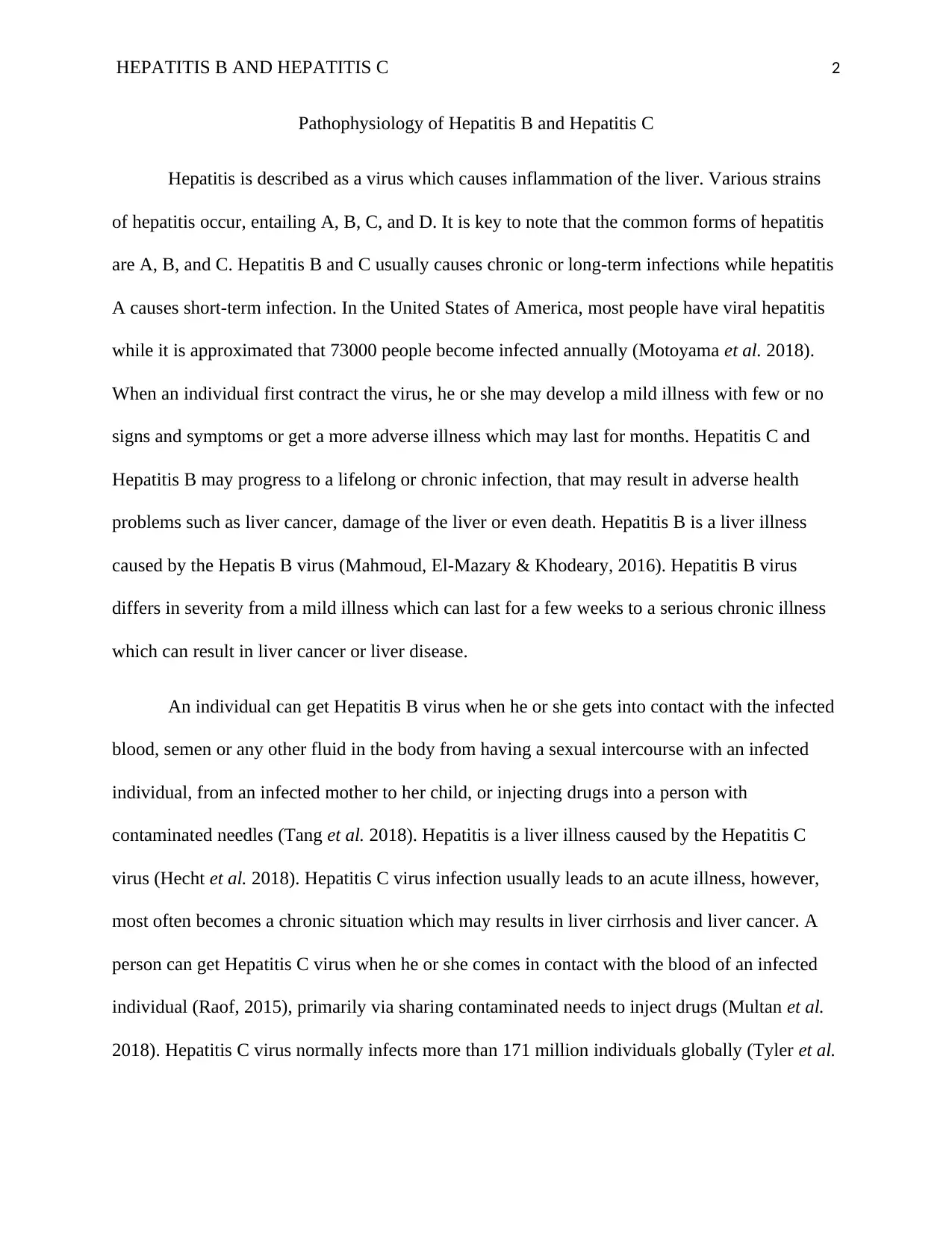
HEPATITIS B AND HEPATITIS C 2
Pathophysiology of Hepatitis B and Hepatitis C
Hepatitis is described as a virus which causes inflammation of the liver. Various strains
of hepatitis occur, entailing A, B, C, and D. It is key to note that the common forms of hepatitis
are A, B, and C. Hepatitis B and C usually causes chronic or long-term infections while hepatitis
A causes short-term infection. In the United States of America, most people have viral hepatitis
while it is approximated that 73000 people become infected annually (Motoyama et al. 2018).
When an individual first contract the virus, he or she may develop a mild illness with few or no
signs and symptoms or get a more adverse illness which may last for months. Hepatitis C and
Hepatitis B may progress to a lifelong or chronic infection, that may result in adverse health
problems such as liver cancer, damage of the liver or even death. Hepatitis B is a liver illness
caused by the Hepatis B virus (Mahmoud, El-Mazary & Khodeary, 2016). Hepatitis B virus
differs in severity from a mild illness which can last for a few weeks to a serious chronic illness
which can result in liver cancer or liver disease.
An individual can get Hepatitis B virus when he or she gets into contact with the infected
blood, semen or any other fluid in the body from having a sexual intercourse with an infected
individual, from an infected mother to her child, or injecting drugs into a person with
contaminated needles (Tang et al. 2018). Hepatitis is a liver illness caused by the Hepatitis C
virus (Hecht et al. 2018). Hepatitis C virus infection usually leads to an acute illness, however,
most often becomes a chronic situation which may results in liver cirrhosis and liver cancer. A
person can get Hepatitis C virus when he or she comes in contact with the blood of an infected
individual (Raof, 2015), primarily via sharing contaminated needs to inject drugs (Multan et al.
2018). Hepatitis C virus normally infects more than 171 million individuals globally (Tyler et al.
Pathophysiology of Hepatitis B and Hepatitis C
Hepatitis is described as a virus which causes inflammation of the liver. Various strains
of hepatitis occur, entailing A, B, C, and D. It is key to note that the common forms of hepatitis
are A, B, and C. Hepatitis B and C usually causes chronic or long-term infections while hepatitis
A causes short-term infection. In the United States of America, most people have viral hepatitis
while it is approximated that 73000 people become infected annually (Motoyama et al. 2018).
When an individual first contract the virus, he or she may develop a mild illness with few or no
signs and symptoms or get a more adverse illness which may last for months. Hepatitis C and
Hepatitis B may progress to a lifelong or chronic infection, that may result in adverse health
problems such as liver cancer, damage of the liver or even death. Hepatitis B is a liver illness
caused by the Hepatis B virus (Mahmoud, El-Mazary & Khodeary, 2016). Hepatitis B virus
differs in severity from a mild illness which can last for a few weeks to a serious chronic illness
which can result in liver cancer or liver disease.
An individual can get Hepatitis B virus when he or she gets into contact with the infected
blood, semen or any other fluid in the body from having a sexual intercourse with an infected
individual, from an infected mother to her child, or injecting drugs into a person with
contaminated needles (Tang et al. 2018). Hepatitis is a liver illness caused by the Hepatitis C
virus (Hecht et al. 2018). Hepatitis C virus infection usually leads to an acute illness, however,
most often becomes a chronic situation which may results in liver cirrhosis and liver cancer. A
person can get Hepatitis C virus when he or she comes in contact with the blood of an infected
individual (Raof, 2015), primarily via sharing contaminated needs to inject drugs (Multan et al.
2018). Hepatitis C virus normally infects more than 171 million individuals globally (Tyler et al.
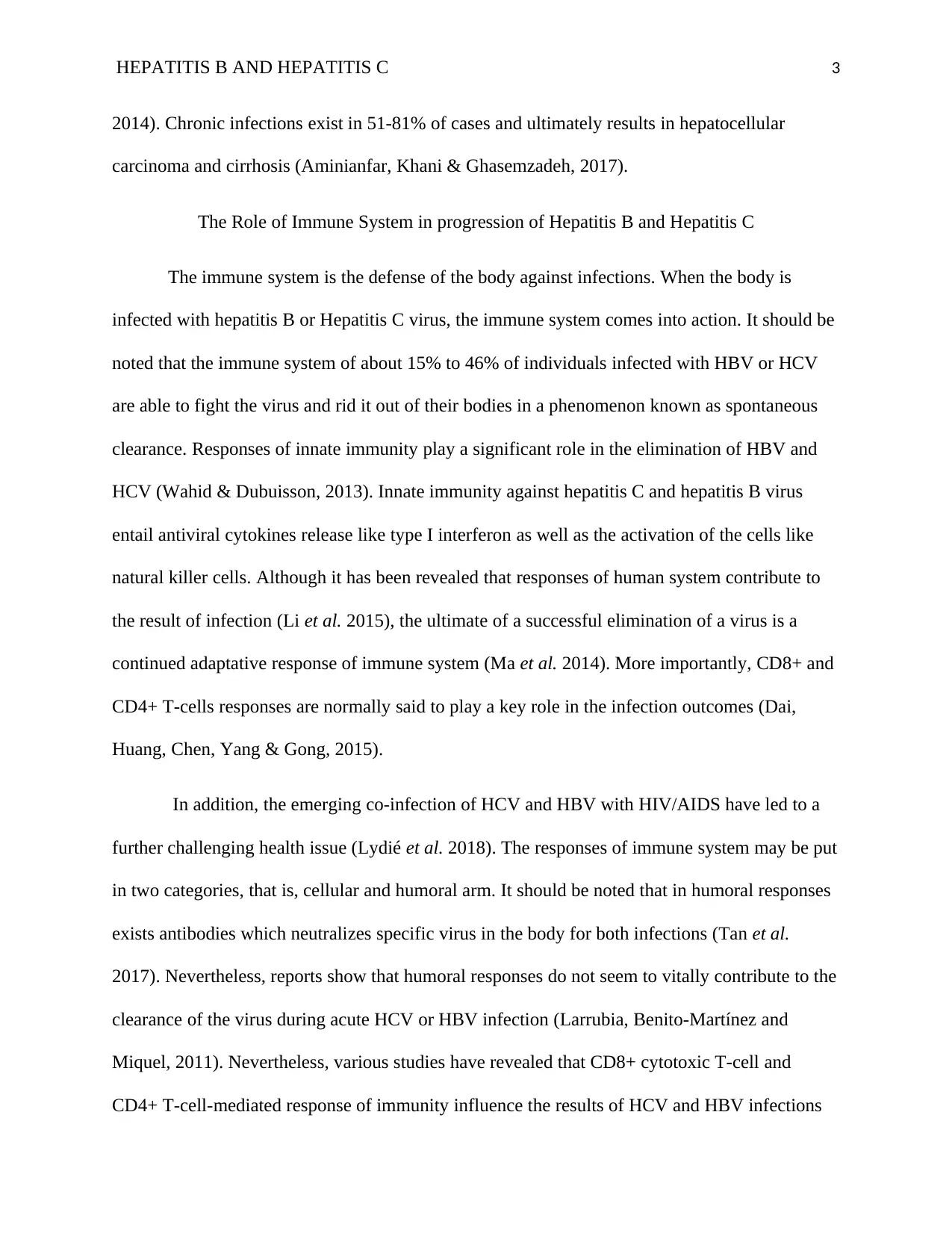
HEPATITIS B AND HEPATITIS C 3
2014). Chronic infections exist in 51-81% of cases and ultimately results in hepatocellular
carcinoma and cirrhosis (Aminianfar, Khani & Ghasemzadeh, 2017).
The Role of Immune System in progression of Hepatitis B and Hepatitis C
The immune system is the defense of the body against infections. When the body is
infected with hepatitis B or Hepatitis C virus, the immune system comes into action. It should be
noted that the immune system of about 15% to 46% of individuals infected with HBV or HCV
are able to fight the virus and rid it out of their bodies in a phenomenon known as spontaneous
clearance. Responses of innate immunity play a significant role in the elimination of HBV and
HCV (Wahid & Dubuisson, 2013). Innate immunity against hepatitis C and hepatitis B virus
entail antiviral cytokines release like type I interferon as well as the activation of the cells like
natural killer cells. Although it has been revealed that responses of human system contribute to
the result of infection (Li et al. 2015), the ultimate of a successful elimination of a virus is a
continued adaptative response of immune system (Ma et al. 2014). More importantly, CD8+ and
CD4+ T-cells responses are normally said to play a key role in the infection outcomes (Dai,
Huang, Chen, Yang & Gong, 2015).
In addition, the emerging co-infection of HCV and HBV with HIV/AIDS have led to a
further challenging health issue (Lydié et al. 2018). The responses of immune system may be put
in two categories, that is, cellular and humoral arm. It should be noted that in humoral responses
exists antibodies which neutralizes specific virus in the body for both infections (Tan et al.
2017). Nevertheless, reports show that humoral responses do not seem to vitally contribute to the
clearance of the virus during acute HCV or HBV infection (Larrubia, Benito-Martínez and
Miquel, 2011). Nevertheless, various studies have revealed that CD8+ cytotoxic T-cell and
CD4+ T-cell-mediated response of immunity influence the results of HCV and HBV infections
2014). Chronic infections exist in 51-81% of cases and ultimately results in hepatocellular
carcinoma and cirrhosis (Aminianfar, Khani & Ghasemzadeh, 2017).
The Role of Immune System in progression of Hepatitis B and Hepatitis C
The immune system is the defense of the body against infections. When the body is
infected with hepatitis B or Hepatitis C virus, the immune system comes into action. It should be
noted that the immune system of about 15% to 46% of individuals infected with HBV or HCV
are able to fight the virus and rid it out of their bodies in a phenomenon known as spontaneous
clearance. Responses of innate immunity play a significant role in the elimination of HBV and
HCV (Wahid & Dubuisson, 2013). Innate immunity against hepatitis C and hepatitis B virus
entail antiviral cytokines release like type I interferon as well as the activation of the cells like
natural killer cells. Although it has been revealed that responses of human system contribute to
the result of infection (Li et al. 2015), the ultimate of a successful elimination of a virus is a
continued adaptative response of immune system (Ma et al. 2014). More importantly, CD8+ and
CD4+ T-cells responses are normally said to play a key role in the infection outcomes (Dai,
Huang, Chen, Yang & Gong, 2015).
In addition, the emerging co-infection of HCV and HBV with HIV/AIDS have led to a
further challenging health issue (Lydié et al. 2018). The responses of immune system may be put
in two categories, that is, cellular and humoral arm. It should be noted that in humoral responses
exists antibodies which neutralizes specific virus in the body for both infections (Tan et al.
2017). Nevertheless, reports show that humoral responses do not seem to vitally contribute to the
clearance of the virus during acute HCV or HBV infection (Larrubia, Benito-Martínez and
Miquel, 2011). Nevertheless, various studies have revealed that CD8+ cytotoxic T-cell and
CD4+ T-cell-mediated response of immunity influence the results of HCV and HBV infections
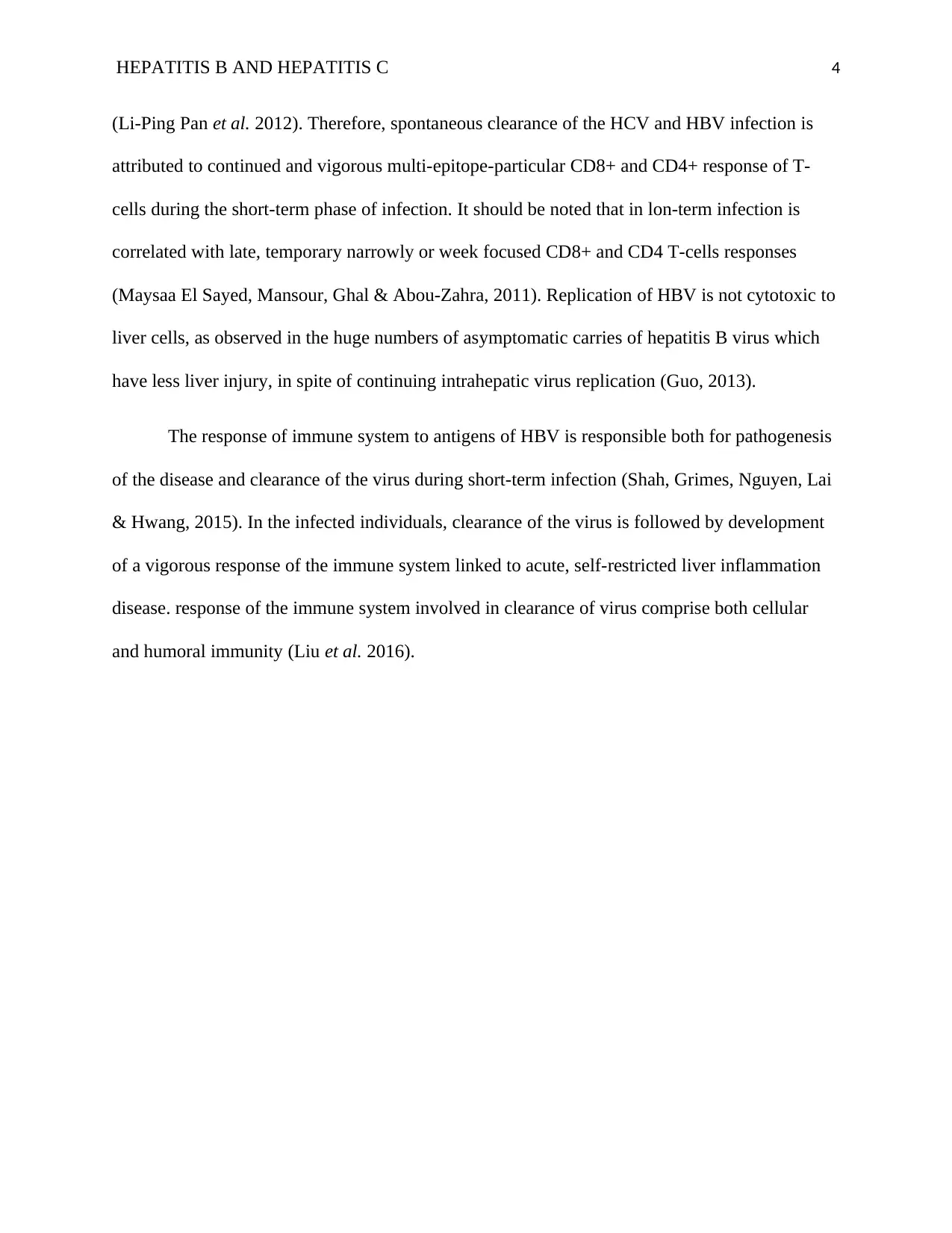
HEPATITIS B AND HEPATITIS C 4
(Li-Ping Pan et al. 2012). Therefore, spontaneous clearance of the HCV and HBV infection is
attributed to continued and vigorous multi-epitope-particular CD8+ and CD4+ response of T-
cells during the short-term phase of infection. It should be noted that in lon-term infection is
correlated with late, temporary narrowly or week focused CD8+ and CD4 T-cells responses
(Maysaa El Sayed, Mansour, Ghal & Abou-Zahra, 2011). Replication of HBV is not cytotoxic to
liver cells, as observed in the huge numbers of asymptomatic carries of hepatitis B virus which
have less liver injury, in spite of continuing intrahepatic virus replication (Guo, 2013).
The response of immune system to antigens of HBV is responsible both for pathogenesis
of the disease and clearance of the virus during short-term infection (Shah, Grimes, Nguyen, Lai
& Hwang, 2015). In the infected individuals, clearance of the virus is followed by development
of a vigorous response of the immune system linked to acute, self-restricted liver inflammation
disease. response of the immune system involved in clearance of virus comprise both cellular
and humoral immunity (Liu et al. 2016).
(Li-Ping Pan et al. 2012). Therefore, spontaneous clearance of the HCV and HBV infection is
attributed to continued and vigorous multi-epitope-particular CD8+ and CD4+ response of T-
cells during the short-term phase of infection. It should be noted that in lon-term infection is
correlated with late, temporary narrowly or week focused CD8+ and CD4 T-cells responses
(Maysaa El Sayed, Mansour, Ghal & Abou-Zahra, 2011). Replication of HBV is not cytotoxic to
liver cells, as observed in the huge numbers of asymptomatic carries of hepatitis B virus which
have less liver injury, in spite of continuing intrahepatic virus replication (Guo, 2013).
The response of immune system to antigens of HBV is responsible both for pathogenesis
of the disease and clearance of the virus during short-term infection (Shah, Grimes, Nguyen, Lai
& Hwang, 2015). In the infected individuals, clearance of the virus is followed by development
of a vigorous response of the immune system linked to acute, self-restricted liver inflammation
disease. response of the immune system involved in clearance of virus comprise both cellular
and humoral immunity (Liu et al. 2016).
Secure Best Marks with AI Grader
Need help grading? Try our AI Grader for instant feedback on your assignments.
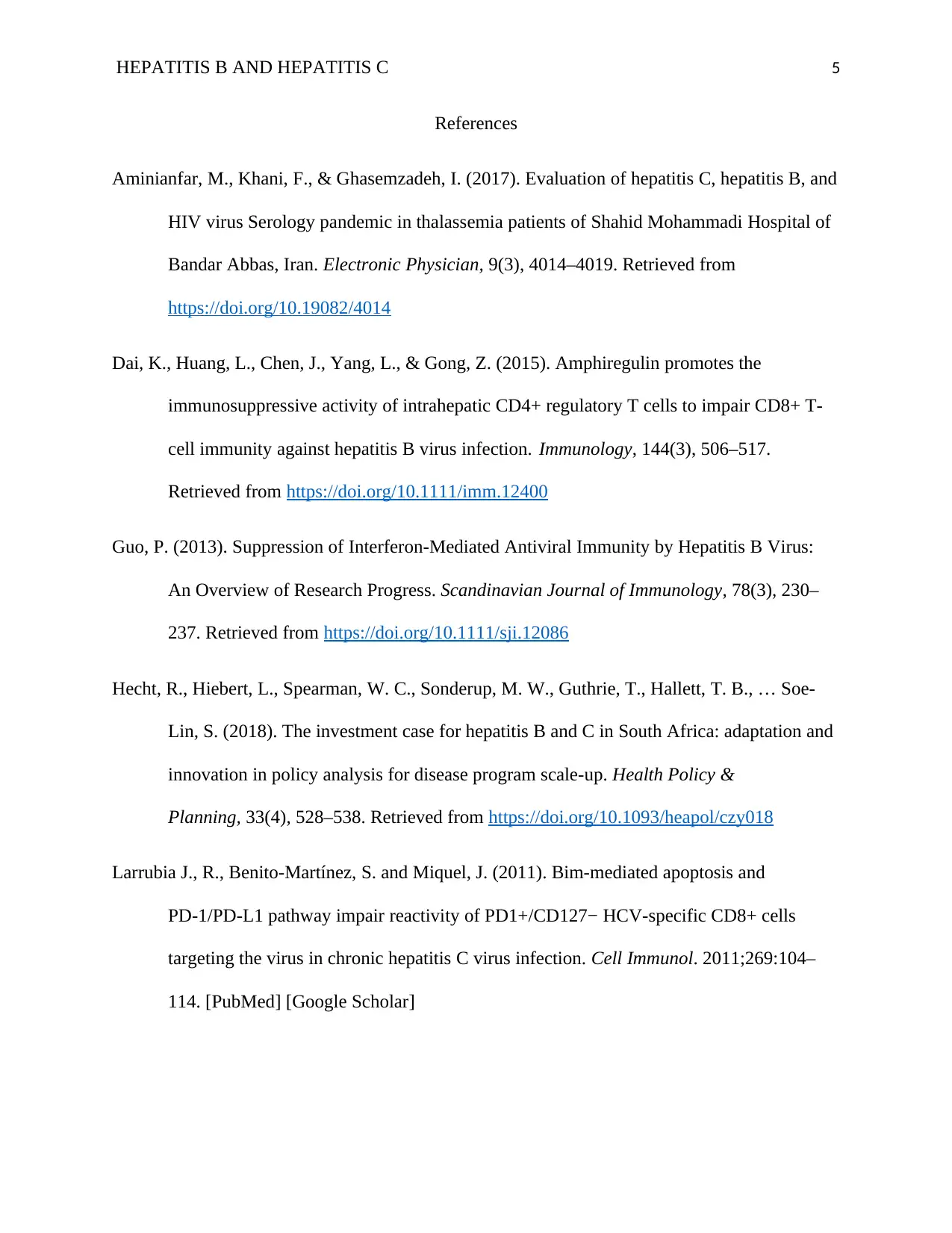
HEPATITIS B AND HEPATITIS C 5
References
Aminianfar, M., Khani, F., & Ghasemzadeh, I. (2017). Evaluation of hepatitis C, hepatitis B, and
HIV virus Serology pandemic in thalassemia patients of Shahid Mohammadi Hospital of
Bandar Abbas, Iran. Electronic Physician, 9(3), 4014–4019. Retrieved from
https://doi.org/10.19082/4014
Dai, K., Huang, L., Chen, J., Yang, L., & Gong, Z. (2015). Amphiregulin promotes the
immunosuppressive activity of intrahepatic CD4+ regulatory T cells to impair CD8+ T-
cell immunity against hepatitis B virus infection. Immunology, 144(3), 506–517.
Retrieved from https://doi.org/10.1111/imm.12400
Guo, P. (2013). Suppression of Interferon-Mediated Antiviral Immunity by Hepatitis B Virus:
An Overview of Research Progress. Scandinavian Journal of Immunology, 78(3), 230–
237. Retrieved from https://doi.org/10.1111/sji.12086
Hecht, R., Hiebert, L., Spearman, W. C., Sonderup, M. W., Guthrie, T., Hallett, T. B., … Soe-
Lin, S. (2018). The investment case for hepatitis B and C in South Africa: adaptation and
innovation in policy analysis for disease program scale-up. Health Policy &
Planning, 33(4), 528–538. Retrieved from https://doi.org/10.1093/heapol/czy018
Larrubia J., R., Benito-Martínez, S. and Miquel, J. (2011). Bim-mediated apoptosis and
PD-1/PD-L1 pathway impair reactivity of PD1+/CD127− HCV-specific CD8+ cells
targeting the virus in chronic hepatitis C virus infection. Cell Immunol. 2011;269:104–
114. [PubMed] [Google Scholar]
References
Aminianfar, M., Khani, F., & Ghasemzadeh, I. (2017). Evaluation of hepatitis C, hepatitis B, and
HIV virus Serology pandemic in thalassemia patients of Shahid Mohammadi Hospital of
Bandar Abbas, Iran. Electronic Physician, 9(3), 4014–4019. Retrieved from
https://doi.org/10.19082/4014
Dai, K., Huang, L., Chen, J., Yang, L., & Gong, Z. (2015). Amphiregulin promotes the
immunosuppressive activity of intrahepatic CD4+ regulatory T cells to impair CD8+ T-
cell immunity against hepatitis B virus infection. Immunology, 144(3), 506–517.
Retrieved from https://doi.org/10.1111/imm.12400
Guo, P. (2013). Suppression of Interferon-Mediated Antiviral Immunity by Hepatitis B Virus:
An Overview of Research Progress. Scandinavian Journal of Immunology, 78(3), 230–
237. Retrieved from https://doi.org/10.1111/sji.12086
Hecht, R., Hiebert, L., Spearman, W. C., Sonderup, M. W., Guthrie, T., Hallett, T. B., … Soe-
Lin, S. (2018). The investment case for hepatitis B and C in South Africa: adaptation and
innovation in policy analysis for disease program scale-up. Health Policy &
Planning, 33(4), 528–538. Retrieved from https://doi.org/10.1093/heapol/czy018
Larrubia J., R., Benito-Martínez, S. and Miquel, J. (2011). Bim-mediated apoptosis and
PD-1/PD-L1 pathway impair reactivity of PD1+/CD127− HCV-specific CD8+ cells
targeting the virus in chronic hepatitis C virus infection. Cell Immunol. 2011;269:104–
114. [PubMed] [Google Scholar]
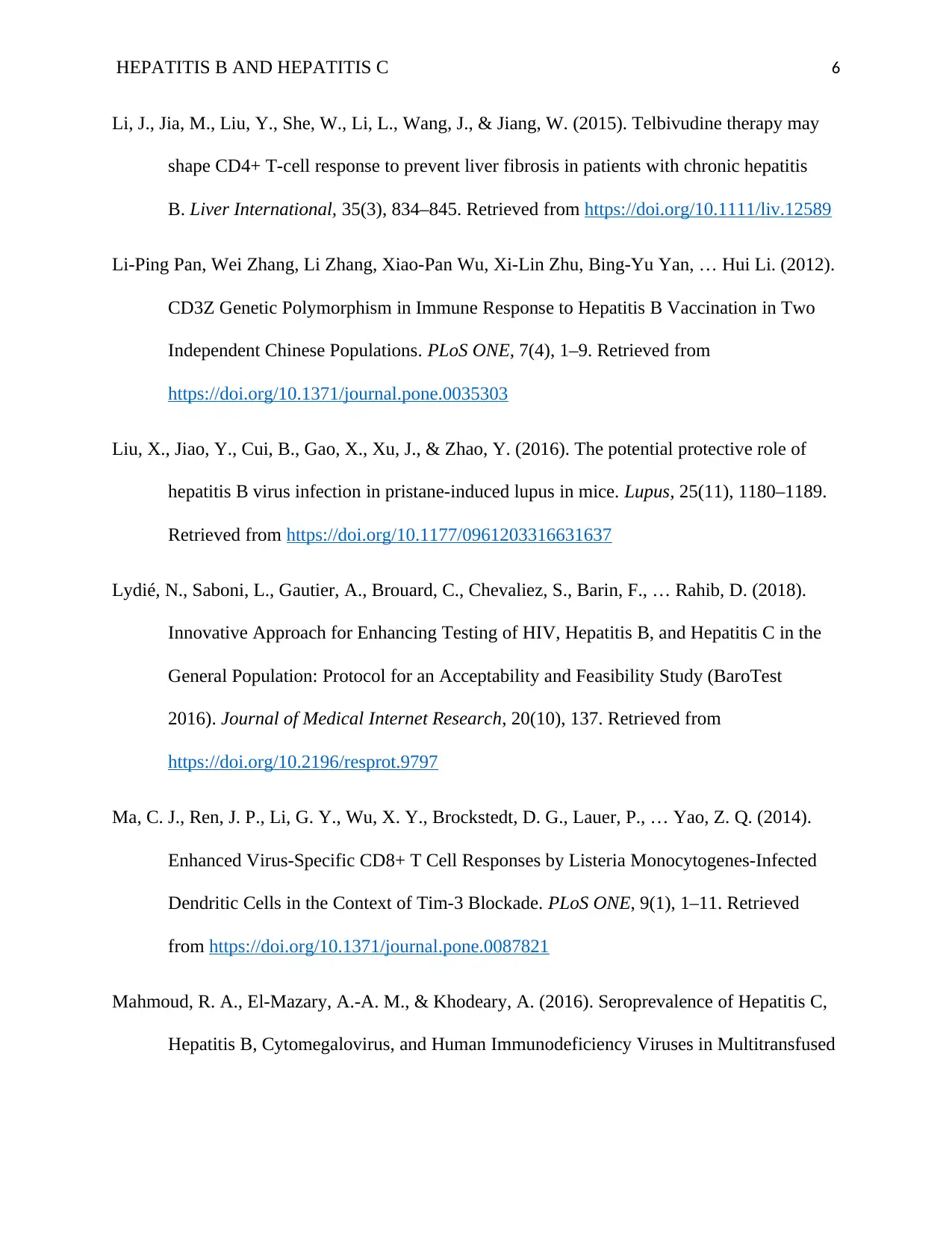
HEPATITIS B AND HEPATITIS C 6
Li, J., Jia, M., Liu, Y., She, W., Li, L., Wang, J., & Jiang, W. (2015). Telbivudine therapy may
shape CD4+ T-cell response to prevent liver fibrosis in patients with chronic hepatitis
B. Liver International, 35(3), 834–845. Retrieved from https://doi.org/10.1111/liv.12589
Li-Ping Pan, Wei Zhang, Li Zhang, Xiao-Pan Wu, Xi-Lin Zhu, Bing-Yu Yan, … Hui Li. (2012).
CD3Z Genetic Polymorphism in Immune Response to Hepatitis B Vaccination in Two
Independent Chinese Populations. PLoS ONE, 7(4), 1–9. Retrieved from
https://doi.org/10.1371/journal.pone.0035303
Liu, X., Jiao, Y., Cui, B., Gao, X., Xu, J., & Zhao, Y. (2016). The potential protective role of
hepatitis B virus infection in pristane-induced lupus in mice. Lupus, 25(11), 1180–1189.
Retrieved from https://doi.org/10.1177/0961203316631637
Lydié, N., Saboni, L., Gautier, A., Brouard, C., Chevaliez, S., Barin, F., … Rahib, D. (2018).
Innovative Approach for Enhancing Testing of HIV, Hepatitis B, and Hepatitis C in the
General Population: Protocol for an Acceptability and Feasibility Study (BaroTest
2016). Journal of Medical Internet Research, 20(10), 137. Retrieved from
https://doi.org/10.2196/resprot.9797
Ma, C. J., Ren, J. P., Li, G. Y., Wu, X. Y., Brockstedt, D. G., Lauer, P., … Yao, Z. Q. (2014).
Enhanced Virus-Specific CD8+ T Cell Responses by Listeria Monocytogenes-Infected
Dendritic Cells in the Context of Tim-3 Blockade. PLoS ONE, 9(1), 1–11. Retrieved
from https://doi.org/10.1371/journal.pone.0087821
Mahmoud, R. A., El-Mazary, A.-A. M., & Khodeary, A. (2016). Seroprevalence of Hepatitis C,
Hepatitis B, Cytomegalovirus, and Human Immunodeficiency Viruses in Multitransfused
Li, J., Jia, M., Liu, Y., She, W., Li, L., Wang, J., & Jiang, W. (2015). Telbivudine therapy may
shape CD4+ T-cell response to prevent liver fibrosis in patients with chronic hepatitis
B. Liver International, 35(3), 834–845. Retrieved from https://doi.org/10.1111/liv.12589
Li-Ping Pan, Wei Zhang, Li Zhang, Xiao-Pan Wu, Xi-Lin Zhu, Bing-Yu Yan, … Hui Li. (2012).
CD3Z Genetic Polymorphism in Immune Response to Hepatitis B Vaccination in Two
Independent Chinese Populations. PLoS ONE, 7(4), 1–9. Retrieved from
https://doi.org/10.1371/journal.pone.0035303
Liu, X., Jiao, Y., Cui, B., Gao, X., Xu, J., & Zhao, Y. (2016). The potential protective role of
hepatitis B virus infection in pristane-induced lupus in mice. Lupus, 25(11), 1180–1189.
Retrieved from https://doi.org/10.1177/0961203316631637
Lydié, N., Saboni, L., Gautier, A., Brouard, C., Chevaliez, S., Barin, F., … Rahib, D. (2018).
Innovative Approach for Enhancing Testing of HIV, Hepatitis B, and Hepatitis C in the
General Population: Protocol for an Acceptability and Feasibility Study (BaroTest
2016). Journal of Medical Internet Research, 20(10), 137. Retrieved from
https://doi.org/10.2196/resprot.9797
Ma, C. J., Ren, J. P., Li, G. Y., Wu, X. Y., Brockstedt, D. G., Lauer, P., … Yao, Z. Q. (2014).
Enhanced Virus-Specific CD8+ T Cell Responses by Listeria Monocytogenes-Infected
Dendritic Cells in the Context of Tim-3 Blockade. PLoS ONE, 9(1), 1–11. Retrieved
from https://doi.org/10.1371/journal.pone.0087821
Mahmoud, R. A., El-Mazary, A.-A. M., & Khodeary, A. (2016). Seroprevalence of Hepatitis C,
Hepatitis B, Cytomegalovirus, and Human Immunodeficiency Viruses in Multitransfused
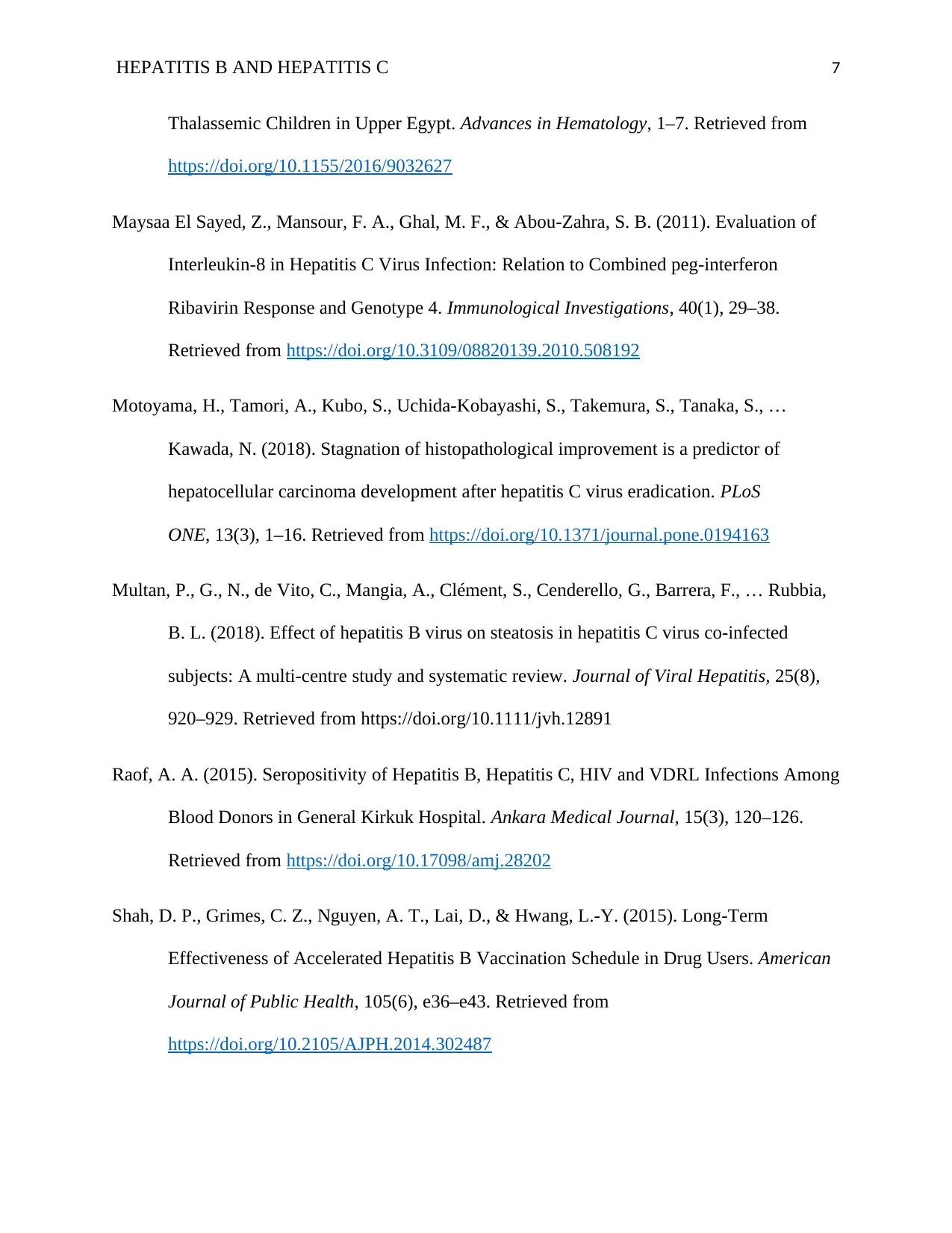
HEPATITIS B AND HEPATITIS C 7
Thalassemic Children in Upper Egypt. Advances in Hematology, 1–7. Retrieved from
https://doi.org/10.1155/2016/9032627
Maysaa El Sayed, Z., Mansour, F. A., Ghal, M. F., & Abou-Zahra, S. B. (2011). Evaluation of
Interleukin-8 in Hepatitis C Virus Infection: Relation to Combined peg-interferon
Ribavirin Response and Genotype 4. Immunological Investigations, 40(1), 29–38.
Retrieved from https://doi.org/10.3109/08820139.2010.508192
Motoyama, H., Tamori, A., Kubo, S., Uchida-Kobayashi, S., Takemura, S., Tanaka, S., …
Kawada, N. (2018). Stagnation of histopathological improvement is a predictor of
hepatocellular carcinoma development after hepatitis C virus eradication. PLoS
ONE, 13(3), 1–16. Retrieved from https://doi.org/10.1371/journal.pone.0194163
Multan, P., G., N., de Vito, C., Mangia, A., Clément, S., Cenderello, G., Barrera, F., … Rubbia,
B. L. (2018). Effect of hepatitis B virus on steatosis in hepatitis C virus co‐infected
subjects: A multi‐centre study and systematic review. Journal of Viral Hepatitis, 25(8),
920–929. Retrieved from https://doi.org/10.1111/jvh.12891
Raof, A. A. (2015). Seropositivity of Hepatitis B, Hepatitis C, HIV and VDRL Infections Among
Blood Donors in General Kirkuk Hospital. Ankara Medical Journal, 15(3), 120–126.
Retrieved from https://doi.org/10.17098/amj.28202
Shah, D. P., Grimes, C. Z., Nguyen, A. T., Lai, D., & Hwang, L.-Y. (2015). Long-Term
Effectiveness of Accelerated Hepatitis B Vaccination Schedule in Drug Users. American
Journal of Public Health, 105(6), e36–e43. Retrieved from
https://doi.org/10.2105/AJPH.2014.302487
Thalassemic Children in Upper Egypt. Advances in Hematology, 1–7. Retrieved from
https://doi.org/10.1155/2016/9032627
Maysaa El Sayed, Z., Mansour, F. A., Ghal, M. F., & Abou-Zahra, S. B. (2011). Evaluation of
Interleukin-8 in Hepatitis C Virus Infection: Relation to Combined peg-interferon
Ribavirin Response and Genotype 4. Immunological Investigations, 40(1), 29–38.
Retrieved from https://doi.org/10.3109/08820139.2010.508192
Motoyama, H., Tamori, A., Kubo, S., Uchida-Kobayashi, S., Takemura, S., Tanaka, S., …
Kawada, N. (2018). Stagnation of histopathological improvement is a predictor of
hepatocellular carcinoma development after hepatitis C virus eradication. PLoS
ONE, 13(3), 1–16. Retrieved from https://doi.org/10.1371/journal.pone.0194163
Multan, P., G., N., de Vito, C., Mangia, A., Clément, S., Cenderello, G., Barrera, F., … Rubbia,
B. L. (2018). Effect of hepatitis B virus on steatosis in hepatitis C virus co‐infected
subjects: A multi‐centre study and systematic review. Journal of Viral Hepatitis, 25(8),
920–929. Retrieved from https://doi.org/10.1111/jvh.12891
Raof, A. A. (2015). Seropositivity of Hepatitis B, Hepatitis C, HIV and VDRL Infections Among
Blood Donors in General Kirkuk Hospital. Ankara Medical Journal, 15(3), 120–126.
Retrieved from https://doi.org/10.17098/amj.28202
Shah, D. P., Grimes, C. Z., Nguyen, A. T., Lai, D., & Hwang, L.-Y. (2015). Long-Term
Effectiveness of Accelerated Hepatitis B Vaccination Schedule in Drug Users. American
Journal of Public Health, 105(6), e36–e43. Retrieved from
https://doi.org/10.2105/AJPH.2014.302487
Paraphrase This Document
Need a fresh take? Get an instant paraphrase of this document with our AI Paraphraser
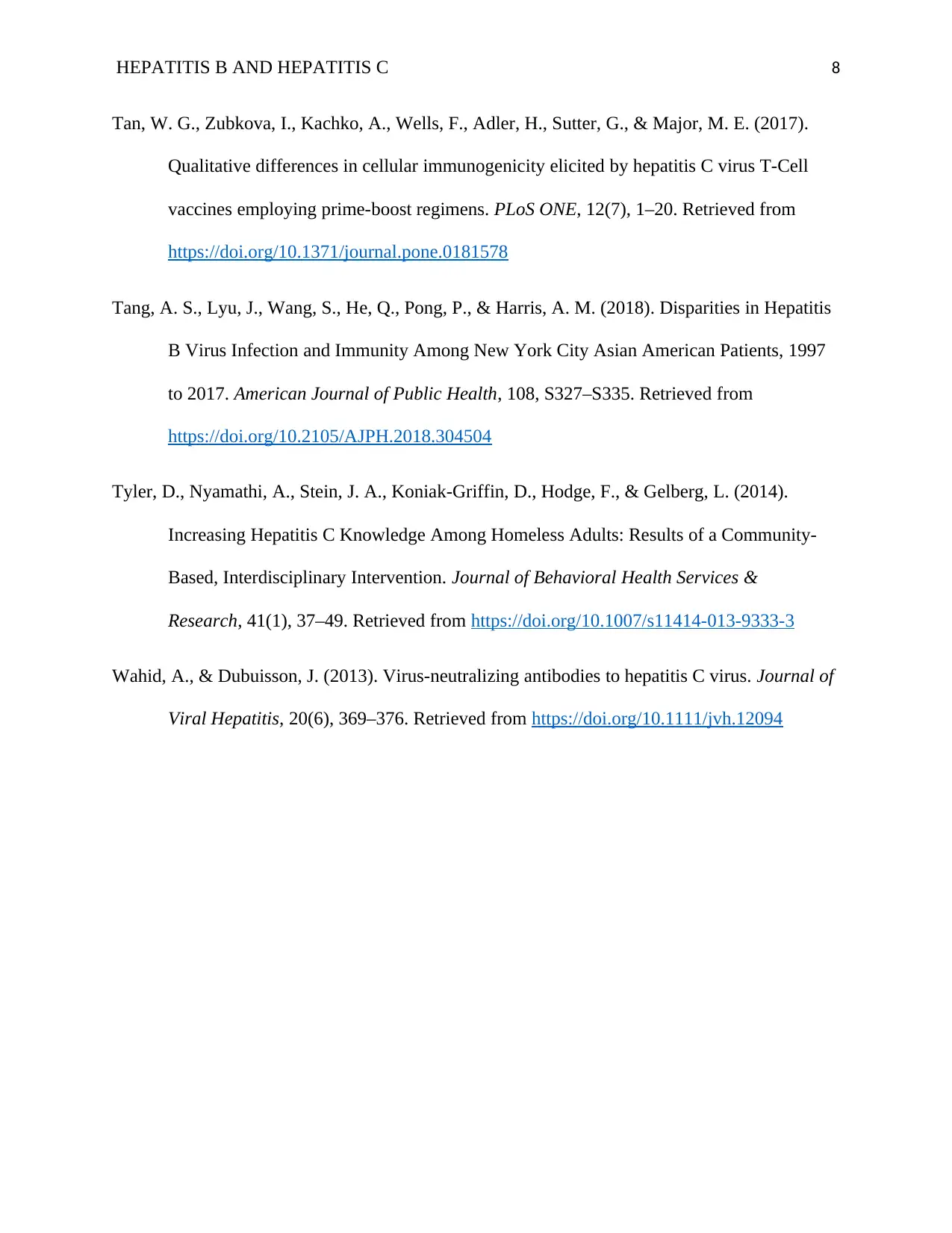
HEPATITIS B AND HEPATITIS C 8
Tan, W. G., Zubkova, I., Kachko, A., Wells, F., Adler, H., Sutter, G., & Major, M. E. (2017).
Qualitative differences in cellular immunogenicity elicited by hepatitis C virus T-Cell
vaccines employing prime-boost regimens. PLoS ONE, 12(7), 1–20. Retrieved from
https://doi.org/10.1371/journal.pone.0181578
Tang, A. S., Lyu, J., Wang, S., He, Q., Pong, P., & Harris, A. M. (2018). Disparities in Hepatitis
B Virus Infection and Immunity Among New York City Asian American Patients, 1997
to 2017. American Journal of Public Health, 108, S327–S335. Retrieved from
https://doi.org/10.2105/AJPH.2018.304504
Tyler, D., Nyamathi, A., Stein, J. A., Koniak-Griffin, D., Hodge, F., & Gelberg, L. (2014).
Increasing Hepatitis C Knowledge Among Homeless Adults: Results of a Community-
Based, Interdisciplinary Intervention. Journal of Behavioral Health Services &
Research, 41(1), 37–49. Retrieved from https://doi.org/10.1007/s11414-013-9333-3
Wahid, A., & Dubuisson, J. (2013). Virus-neutralizing antibodies to hepatitis C virus. Journal of
Viral Hepatitis, 20(6), 369–376. Retrieved from https://doi.org/10.1111/jvh.12094
Tan, W. G., Zubkova, I., Kachko, A., Wells, F., Adler, H., Sutter, G., & Major, M. E. (2017).
Qualitative differences in cellular immunogenicity elicited by hepatitis C virus T-Cell
vaccines employing prime-boost regimens. PLoS ONE, 12(7), 1–20. Retrieved from
https://doi.org/10.1371/journal.pone.0181578
Tang, A. S., Lyu, J., Wang, S., He, Q., Pong, P., & Harris, A. M. (2018). Disparities in Hepatitis
B Virus Infection and Immunity Among New York City Asian American Patients, 1997
to 2017. American Journal of Public Health, 108, S327–S335. Retrieved from
https://doi.org/10.2105/AJPH.2018.304504
Tyler, D., Nyamathi, A., Stein, J. A., Koniak-Griffin, D., Hodge, F., & Gelberg, L. (2014).
Increasing Hepatitis C Knowledge Among Homeless Adults: Results of a Community-
Based, Interdisciplinary Intervention. Journal of Behavioral Health Services &
Research, 41(1), 37–49. Retrieved from https://doi.org/10.1007/s11414-013-9333-3
Wahid, A., & Dubuisson, J. (2013). Virus-neutralizing antibodies to hepatitis C virus. Journal of
Viral Hepatitis, 20(6), 369–376. Retrieved from https://doi.org/10.1111/jvh.12094
1 out of 8
Related Documents
Your All-in-One AI-Powered Toolkit for Academic Success.
+13062052269
info@desklib.com
Available 24*7 on WhatsApp / Email
![[object Object]](/_next/static/media/star-bottom.7253800d.svg)
Unlock your academic potential
© 2024 | Zucol Services PVT LTD | All rights reserved.




